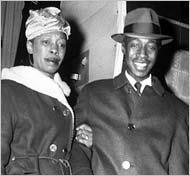Clyde Kennard facts for kids
Quick facts for kids
Clyde Kennard
|
|
|---|---|

Kennard, then terminally ill, meeting sister Sara Tarpley on arrival in Chicago after release in 1963.
|
|
| Born | June 12, 1927 |
| Died | July 4, 1963 (aged 36) |
Clyde Kennard (June 12, 1927 – July 4, 1963) was a brave American Korean War veteran and a leader in the civil rights movement. He was born in Hattiesburg, Mississippi. In the 1950s, he tried to enroll at a college that was only for white students. This was called segregation, and it meant Black and white people were kept separate. Clyde wanted to finish his college degree, but the college said no because of his race.
Even though the highest court in the U.S. had said in 1954 that keeping public schools separate was wrong, the college still rejected him. Clyde was one of many people who fought for equal rights during this time.
Contents
Fighting for Education Equality
Clyde Kennard wanted to complete his college degree. He had started his studies at the University of Chicago. In the 1950s, he tried several times to join Mississippi Southern College. This college is now known as the University of Southern Mississippi. At that time, it was an all-white school.
Why Was College Enrollment a Challenge?
In the 1950s, many parts of the southern United States still had strict rules. These rules were called Jim Crow laws. They kept Black and white people separate in schools, buses, and public places. This separation was known as racial segregation.
The U.S. Supreme Court had ruled in 1954 that segregation in public schools was against the law. This ruling was called Brown v. Board of Education. Even with this ruling, many states in the South resisted. They did not want to integrate their schools.
Clyde's Efforts to Enroll
Clyde Kennard bravely tried to enroll at Mississippi Southern College. He wanted to show that everyone deserved a chance at education. His attempts were important because they challenged the unfair system of segregation. He became a symbol for many others who wanted equal opportunities.
Unfair Treatment and Imprisonment
Clyde Kennard wrote a letter to a local newspaper. In his letter, he spoke about the importance of integrated education. This meant that Black and white students should be able to learn together. His letter made some powerful people angry.
The State's Response
A state-supported group called the Mississippi State Sovereignty Commission worked against him. They planned to have him arrested on charges that were not true. This was a way to stop him from fighting for civil rights.
Life in Prison
Clyde was found guilty of these false charges. He was sent to Parchman Penitentiary, a very tough state prison. He was sentenced to seven years there. While in prison, Clyde became very sick. He developed cancer, which was a serious illness.
Release and Legacy
Clyde Kennard's health got much worse in prison. He became terminally ill, meaning his illness could not be cured. His supporters worked hard to get him released.
A Fight for Freedom
The state governor at the time refused to give him a full pardon. However, he was released on parole in January 1963. Parole means he was allowed to leave prison early but was still under supervision. Clyde died just a few months later, in July 1963, at the age of 36.
Clearing His Name
Years later, in 2005, new information came out. It showed clearly that Clyde Kennard had been framed. This meant the charges against him were false from the start. People who supported Clyde wanted his name cleared. They tried to get a pardon for him after his death. This is called a posthumous pardon.
The governor at the time, Haley Barbour, first refused. But supporters kept working. They convinced Governor Barbour to help them ask the court to look at Clyde's case again. In 2006, the court officially overturned his conviction. This meant that Clyde Kennard was finally proven innocent. His fight for justice and equality is still remembered today.

